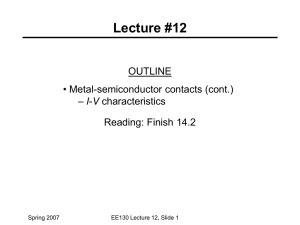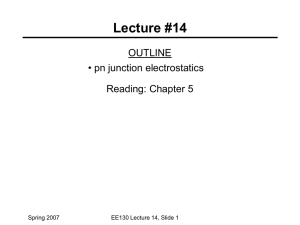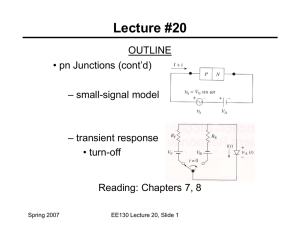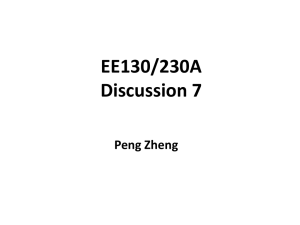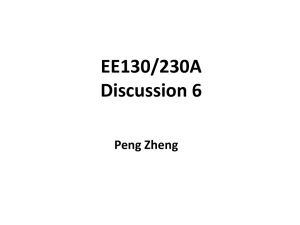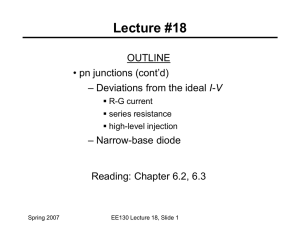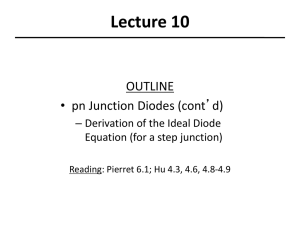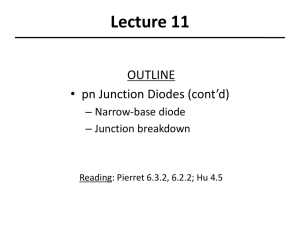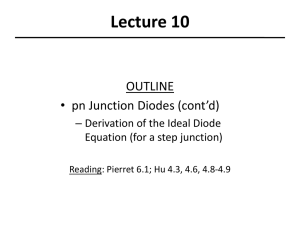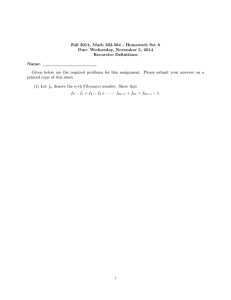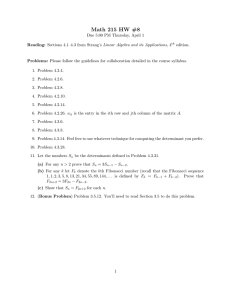Lectures 15 and 16
advertisement
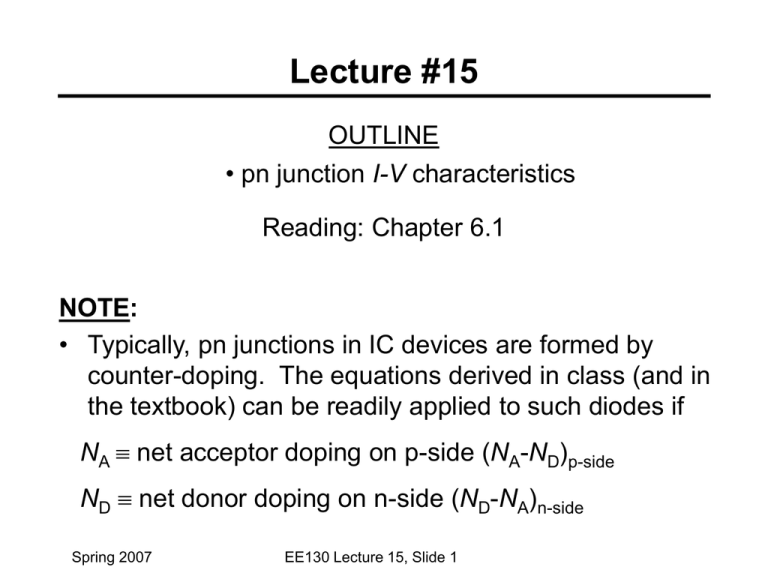
Lecture #15 OUTLINE • pn junction I-V characteristics Reading: Chapter 6.1 NOTE: • Typically, pn junctions in IC devices are formed by counter-doping. The equations derived in class (and in the textbook) can be readily applied to such diodes if NA net acceptor doping on p-side (NA-ND)p-side ND net donor doping on n-side (ND-NA)n-side Spring 2007 EE130 Lecture 15, Slide 1 Linearly Graded Junction Spring 2007 EE130 Lecture 15, Slide 2 Biased PN Junctions Note that VA should be significantly smaller than Vbi (Otherwise, we cannot assume low-level injection) Spring 2007 EE130 Lecture 15, Slide 3 Effect of Bias on Electrostatics Spring 2007 EE130 Lecture 15, Slide 4 pn Junction Electrostatics, VA 0 • Built-in potential Vbi (non-degenerate doping): kT N A kT N D kT N A N D Vbi ln ln ln 2 q ni q ni q ni • Depletion width W : 1 2 s 1 W x p xn (Vbi VA ) q N A ND ND xp W N A ND Spring 2007 NA xn W N A ND EE130 Lecture 15, Slide 5 • Electric field distribution (x) • Potential distribution V(x) ND Note that V (0) (Vbi VA ) N A ND Spring 2007 EE130 Lecture 15, Slide 6 Peak Electric Field 1 dx 2 (0) W Vbi VA • For a one-sided junction: W 2 s (Vbi VA ) qN 2Vbi VA 2qN Vbi VA therefore (0) W s Spring 2007 EE130 Lecture 15, Slide 7 Current Flow - Qualitative Spring 2007 EE130 Lecture 15, Slide 8 Current Flow in a pn Junction Diode • When a forward bias (VA>0) is applied, the potential barrier to diffusion across the junction is reduced – Minority carriers are “injected” into the quasineutral regions => Dnp > 0, Dpn > 0 • Minority carriers diffuse in the quasi-neutral regions, recombining with majority carriers Spring 2007 EE130 Lecture 15, Slide 9 • Current density J = Jn(x) + Jp(x) dn d ( Dn ) J n ( x ) qn n qDn qn n qDn dx dx dp d ( Dp ) J p ( x ) q p p qD p q p p qD p dx dx • J is constant throughout the diode, but Jn(x) and Jp(x) vary with position Spring 2007 EE130 Lecture 15, Slide 10 Ideal Diode Analysis: Assumptions • Non-degenerately doped step junction • Steady-state conditions • Low-level injection conditions prevail in the quasi-neutral regions • Recombination-generation is negligible in the depletion region dJ n 0, dx dJ p dx 0 i.e. Jn & Jp are constant inside the depletion region Spring 2007 EE130 Lecture 15, Slide 11 Ideal Diode Analysis: Approach • Solve the minority-carrier diffusion equations in quasi-neutral regions to obtain Dnp(x,VA),Dpn(x,VA) – apply boundary conditions • p-side: Dnp(-xp), Dnp(-) • n-side: Dpn(xn), Dpn() • Determine minority-carrier current densities in quasineutral regions d ( Dn p ) d ( Dpn ) J p ( x,VA ) qD p J n ( x,VA ) qDn dx dx • Evaluate Jn at x=-xp and Jp at x=xn J(VA) = Jn(VA)|x=-xp + Jp(VA )|x=xn Spring 2007 EE130 Lecture 15, Slide 12 Carrier Concentrations at –xp, xn Consider the equilibrium (VA = 0) carrier concentrations: p-side n-side p p 0 ( x p ) N A nn 0 ( xn ) N D 2 i n n p 0 ( x p ) NA 2 i n p n 0 ( xn ) ND If low-level injection conditions prevail in the quasi-neutral regions when VA 0, then p p ( x p ) N A Spring 2007 nn ( xn ) N D EE130 Lecture 15, Slide 13 “Law of the Junction” The voltage VA applied to a pn junction falls mostly across the depletion region (assuming that low-level injection conditions prevail in the quasi-neutral regions). We can draw 2 quasi-Fermi levels in the depletion region: p ni e( Ei FP ) / kT n ni e( FN Ei ) / kT pn ni2e( Ei FP ) / kT e( FN Ei ) / kT ni2e( FN FP ) / kT pn ni2eqVA / kT Spring 2007 EE130 Lecture 15, Slide 14 Excess Carrier Concentrations at –xp, xn p-side n-side p p ( x p ) N A nn ( xn ) N D ni2 e qVA / kT n p ( x p ) NA ni2 e qVA / kT p n ( xn ) ND n p 0 e qVA / kT 2 i pn 0 e qVA / kT n Dn p ( x p ) e qVA / kT 1 NA Spring 2007 2 i n Dpn ( xn ) e qVA / kT 1 ND EE130 Lecture 15, Slide 15 Example: Carrier Injection A pn junction has NA=1018 cm-3 and ND=1016 cm-3. The applied voltage is 0.6 V. Question: What are the minority carrier concentrations at the depletion-region edges? qV Answer: n p ( x p ) n poe A pn ( xn ) pnoe qVA kT kT 100 e0.6 0.026 1012 cm-3 104 e0.6 0.026 1014 cm -3 Question: What are the excess minority carrier concentrations? Answer: Dn p ( x p ) n p ( x p ) n po 1012 100 1012 cm-3 Dpn ( xn ) pn ( xn ) pno 1014 104 1014 cm -3 Spring 2007 EE130 Lecture 15, Slide 16 Excess Carrier Distribution d 2 Dpn Dpn Dpn dx 2 Dp p Lp 2 • From the minority carrier diffusion equation: • We have the following boundary conditions: Dpn ( xn ) pno (e qVA / kT 1) Dpn () 0 • For simplicity, we will develop a new coordinate system: NEW: x’’ 0 0 x’ • Then, the solution is of the form: Dpn ( x' ) A1e Spring 2007 x '/ L p A2e EE130 Lecture 15, Slide 17 x '/ L p Dpn ( x' ) A1e x ' / Lp A2e x ' / Lp From the x = boundary condition, A1 = 0. qVA / kT A p ( e 1) From the x = xn boundary condition, 2 no Therefore, Dpn ( x' ) pno (e qVA / kT 1)e x ' / Lp , x' 0 Similarly, we can derive Dn p ( x' ' ) n po (eqVA / kT 1)e x ''/ Ln , x' ' 0 Spring 2007 EE130 Lecture 15, Slide 18 pn Diode I-V Characteristic dDn p ( x' ' ) p-side: J n qDn dx' ' Dn q n p 0 (e qVA Ln Dp dDpn ( x' ) qVA n-side: J p qD p q pn 0 (e dx' Lp J J n x x J p p x xn J n x0 J p Dn D p qVA J qn ( e Ln N A Lp N D 2 i Spring 2007 EE130 Lecture 15, Slide 19 kT x 0 1) kT 1)e x '' Ln kT x' Lp 1)e I I 0 (e qVA kT 1) Dp D n I 0 Aqni L N L N p D n A 2 Spring 2007 EE130 Lecture 15, Slide 20 Diode Saturation Current I0 Dp D n I 0 Aqni L N L N p D n A 2 • I0 can vary by orders of magnitude, depending on the semiconductor material • In an asymmetrically doped pn junction, the term associated with the more heavily doped side is negligible: Dp – If the p side is much more heavily doped, I 0 Aqni L N p D 2 Dn – If the n side is much more heavily doped, I 0 Aqni Ln N A 2 Spring 2007 EE130 Lecture 15, Slide 21 Summary • The total voltage dropped across a pn junction is Vbi-VA: 2 s Vbi VA 1 1 – Depletion-layer width W q N A ND 2Vbi VA – Peak electric field (0) W • Under forward bias (VA > 0), the potential barrier to carrier diffusion is reduced minority carriers are “injected” and diffuse in the quasi-neutral regions Dn D p qVA Diode current I qAn (e Ln N A L p N D 2 i Spring 2007 EE130 Lecture 15, Slide 22 kT 1)
